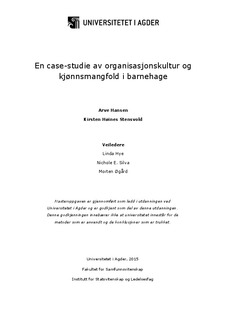| dc.contributor.author | Hansen, Arve | |
| dc.contributor.author | Stensvold, Kirsten Høines | |
| dc.date.accessioned | 2016-02-23T07:30:58Z | |
| dc.date.available | 2016-02-23T07:30:58Z | |
| dc.date.issued | 2015 | |
| dc.identifier.uri | http://hdl.handle.net/11250/2380009 | |
| dc.description | Masteroppgave ledelse- Universitetet i Agder, 2015 | nb_NO |
| dc.description.abstract | The nursery sector has been in a huge development over the past 20 years. The kindergartens
are female dominated and about 90 % of the employees in Norwegian kindergartens are
women. Few places in our society have such big gender domination. Nevertheless today more
and more kindergartens employ both men and women, and in our thesis we wish to examine
the kindergarten culture in a gender perspective. Do we see any cultural differences or
similarities when the staffs are homogeneous or they represent gender diversity?
We have completed a case study in witch we use a mapping tool called Organizational
Cultural Assessment Instrument (OCAI), to provide new knowledge about organizational
culture in kindergartens. In our study we have detected organizational culture all together, and
the only difference were if the staff represented gender diversity or not.
The mapping shows that the organization culture in kindergartens are characterized by a
social and cooperation focused environment (fig. 6). Men and women answer mostly similar
in their description of the kindergarten culture, but men seems to represent a counterweight to
the cooperation environment (fig. 9). However, we see at big gap in culture perception when
we compare every case with and without gender diversity (fig. 7, 8). The differences are
biggest in the adhocracy and hierarchy culture. The kindergartens with staff of gender
diversity perceive the organizational culture as less control orientated and more innovative
regarding to creativity and possibilities.
Our culture analysis shows that there are especially differences in women’s cultural
perspective (fig. 10.) Women in kindergartens with gender diversity describe another
organizational culture with adhocracy and less control (fig. 12). The homogeneous
kindergarten is represented with an intimate and control culture, and they are internal focused.
In the work with our issue we analysed some preferably cultural profiles (fig. 13, 14, 15).
They shows that the differences we´ve spotted earlier are increasing. This can make a huge
impact in the future.
Gender diversity in kindergartens seems to have positive synergies, and we see that gender
diversity can be an important issue to address considering the quality debate in kindergartens.
In our study, we see some indications that gender diversity in organizations can cause the
children, the staff and the whole organization development to benefit from it. | nb_NO |
| dc.language.iso | nob | nb_NO |
| dc.publisher | Universitetet i Agder ; University of Agder | nb_NO |
| dc.subject.classification | ORG 917 | |
| dc.title | En case-studie av organisasjonskultur og kjønnsmangfold i barnehage | nb_NO |
| dc.type | Master thesis | nb_NO |
| dc.subject.nsi | VDP::Social science: 200::Political science and organizational theory: 240::Public and private administration: 242 | nb_NO |
| dc.source.pagenumber | 90 s. | nb_NO |
